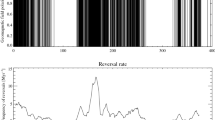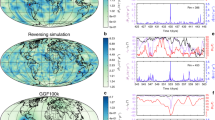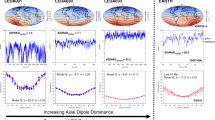Abstract
Palaeomagnetic studies of the reversal of the geomagnetic field have produced a number of palaeomagnetic records of intermediate or transition fields during reversals. These transition fields may provide an important clue as to the nature of the geodynamo. During the last reversal, the geomagnetic field was no longer dipolar1, but the field appeared to be dominated by low-order harmonics2–4. Such transition-field geometries predict that all palaeomagnetic records will include high inclinations of either + or − 90°, which give the virtual geomagnetic pole paths passing through the site or its antipode. Subsequently, when transition records were found not showing these characteristics, the idea of the dominance of low-order zonals was questioned. Here we show that if the low-order zonals are combined with a drifting non-dipole field, similar to that seen at present, most of the features of reversal transitions can be simulated. We therefore suggest that low-order zonals may indeed dominate transition fields, but they are accompanied by some form of drifting non-dipole field.
This is a preview of subscription content, access via your institution
Access options
Subscribe to this journal
Receive 51 print issues and online access
$199.00 per year
only $3.90 per issue
Buy this article
- Purchase on Springer Link
- Instant access to full article PDF
Prices may be subject to local taxes which are calculated during checkout
Similar content being viewed by others
References
Hillhouse, J. W. & Cox, A. Earth planet. Sci. Lett. 29, 51–64 (1976).
Hoffman, K. A. Science 196, 1329–1333 (1977).
Hoffman, K. A. & Fuller, M. Nature 273, 715–718 (1978).
Williams, I. & Fuller, M. J. geophys. Res. 86, 11657–11665 (1981).
Valet, J-P, Laj, C. & Tucholka, P. Nature 322, 27–32 (1986).
Niitsuma, N. Sci. Rep. Tohuku Univ. Ser. 2. 43, 1–39 (1971).
Dodson, R. et al. Geophys. J. R. astr. Soc. 53, 373–412 (1978).
Merrill, R. T. & McElhinny, M. W. The Earth's Magnetic Field (Academic, New York, 1983).
Author information
Authors and Affiliations
Rights and permissions
About this article
Cite this article
Williams, I., Weeks, R. & Fuller, M. A model for transition fields during geomagnetic reversals. Nature 332, 719–720 (1988). https://doi.org/10.1038/332719a0
Received:
Accepted:
Issue Date:
DOI: https://doi.org/10.1038/332719a0
This article is cited by
Comments
By submitting a comment you agree to abide by our Terms and Community Guidelines. If you find something abusive or that does not comply with our terms or guidelines please flag it as inappropriate.



